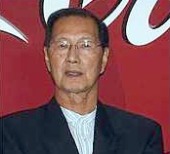YEW Cheng Hoe is a well-known community leader in Petaling Jaya. The lanky elderly man heads the Damansara Jaya Owners and Residents Association, one of the best organised neighbourhoods in the country.
The 67-year-old devotes almost all his time to serving his neighbours, acting like an elected representative – if not more effective than one. The residents call him up for everything, from domestic disputes to maids running away, and they expect him to solve their problems.
 Yew: He had to retire from competitive badminton when he was only 28 because he tore his Achilles tendon.
Yew: He had to retire from competitive badminton when he was only 28 because he tore his Achilles tendon. His passion is in organising community protests against the construction of high-rise buildings in Damansara Jaya in the name of redevelopment. It’s a thankless job but Yew, who is still hale and hearty, is familiar with being unrecognised and unappreciated.
Not many in the neighbourhood, including the older ones, are aware that Yew is one of Malaysia’s greatest sports legends.
He was one of the members of the victorious 1967 Thomas Cup team, and they won the prize in what could be described as the fiercest and most emotional contest in Thomas Cup history.
With Malaysia leading four matches to three in the best of nine series, the play had to be suspended during the eighth match due to unruly crowd behaviour.
The 15,000-strong Indonesian crowd at the Senayan sports hall was fanatical. The Malaysian players were abused and jeered while slippers and bottles were thrown at them on the court. Even torchlights and camera flash lights were reportedly shone on them to distract them and make them lose their focus on the game.
Indonesia’s Rudy Hartono, not yet 18 then, had just made his debut in the Thomas Cup, certainly the most important international badminton competition in the world.
The chaotic night ended with the International Badminton Federation giving a 6-3 victory to Malaysia.
Today, members of the 1967 team – Yew, Teh Kew San, Tan Yee Khan, Ng Boon Bee, Billy Ng, Tan Aik Huang and Tan Aik Mong – are still around.
So is Rudy Hartono, now 60 years old and a pastor at the Bethel Church in Jakarta.
But while we have been quick to reward our younger sportsmen and sportswomen with titles and money, we seem to have forgotten, if not neglected, those who did better in the past.
They were international giants in international competitions, not flash-in-the-pan winners at regional events. Swimming the English channel would hardly be a feat compared to what they have done.
Except for Teh, Yee Khan and Boon Bee, who have each received a Datukship, the rest – Yew, Billy Ng and the Tan brothers – are still unrecognised. The fact that they did not seek recognition, such as a Datukship, does not mean we should forget their glorious past.
I am told that they are occasionally invited to badminton events but they normally end up in the stands, not the VIP area.
Another time, one of the 1967 greats took a visiting English badminton player to watch the current national team. A prominent player gave him the cold shoulder but Rexy Mainaky, the Indonesian coach of the Malaysian men’s doubles, recognised the elderly gentleman and took time to show him around.
Yew, for example, had to retire from competitive badminton when he was only 28 because he tore his Achilles tendon. Left without financial support for treatment, it also meant the end of his career.
Teh, who captained the 1967 team, worked as a clerk at the Penang Municipal Council and had to take unpaid leave to play badminton for the country.
In 2008, Yew and Billy Ng – perhaps suddenly remembered by the sports bureaucrats – were inducted into the Olympics Council of Malaysia (OCM) Hall of Fame.
Other former sports personalities inducted were Shaharuddin Jaafar, the 1965 SEAP Games gold medallist in cycling, and Datuk Malek Noor, a six-time winner of the Mr Asia crown in the heavyweight category.
The members of the 1967 badminton team are now in the twilight of their lives. They won’t be around with us for long.
Malaysia owes it to them to recognise this special breed of fighters who refused to be cowed by an intimidating crowd.
They kept the Jalur Gemilang flying even at the most difficult moments because they believed in themselves and the country. They knew they could not let Malaysians down.
Their nerves were certainly made of steel and their mental preparations must have been the toughest in Thomas Cup history.
Let’s not let the 1967 team down, just as they kept our faith and hope in them then. Those who have not been accorded titles should be recognised – and soon.





